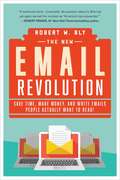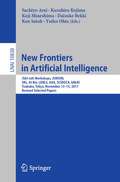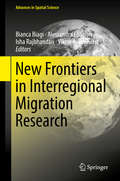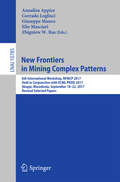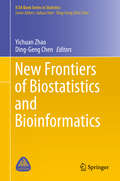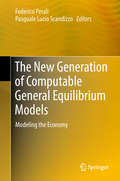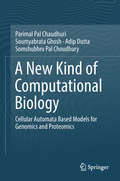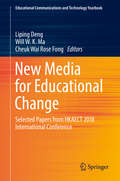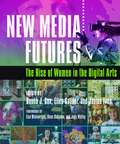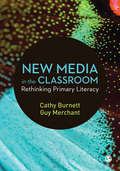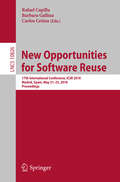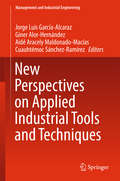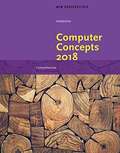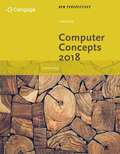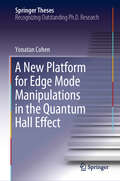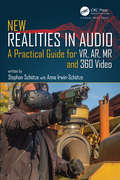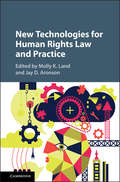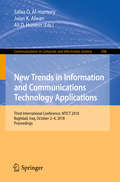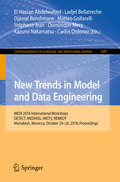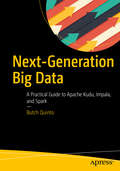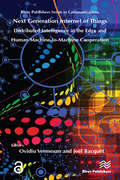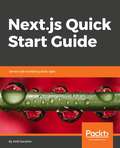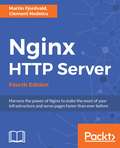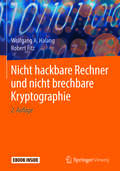- Table View
- List View
The New Email Revolution: Save Time, Make Money, and Write Emails People Actually Want to Read!
by Robert W. BlyPractices, strategies, and templates for optimizing your email use. The average business employee spends more than thirteen hours a week reading and responding to email. That’s 675 or more hours—over 28 days a year—spent on email. Wouldn’t it be nice to get some of that time back? In The New Email Revolution, Robert W. Bly Bly draws from decades of experience sending millions of emails to help you take that time back. With this book in hand, you will be able to quickly and easily: •Find templates you can use to create emails for dozens of different situations. •Know the right wording and optimal word length for email communication. •Get recipients to read and respond to your email messages. •Understand when it is legal and not legal to send email to a person you do not know. •Incorporate photos, graphics, sound, and video into your email messages. •Measure the deliverability, bounce rate, open rate, and response rate to every email you send. •Write clearer, more engaging, more persuasive email copy for every occasion. Get better results in less time with The New Email Revolution.
New Frontiers in Artificial Intelligence: JSAI-isAI Workshops, JURISIN, SKL, AI-Biz, LENLS, AAA, SCIDOCA, kNeXI, Tsukuba, Tokyo, November 13-15, 2017, Revised Selected Papers (Lecture Notes in Computer Science #10838)
by Ken Satoh Daisuke Bekki Koji Mineshima Yuiko Ohta Sachiyo Arai Kazuhiro KojimaThis book constitutes extended, revised and selected papers from the 9th International Symposium of Artificial Intelligence supported by the Japanese Society for Artificial Intelligence, JSAI-isAI 2017. It was held in November 2017 in Tokyo, Japan. The 22 papers were carefully selected from 109 submissions and are organized in sections on juris-informatics, skill science, artificial intelligence of and for business, logic and engineering of natural language semantics, argument for agreement and assurance, scientific document analysis, knowledge explication for industry.
New Frontiers in Interregional Migration Research (Advances in Spatial Science)
by Viktor A. Venhorst Isha Rajbhandari Alessandra Faggian Bianca BiagiThis book focuses on the latest advances and challenges in interregional migration research. Given the increase in the availability of "big data" at a finer spatial scale, the book discusses the resulting new challenges for researchers in interregional migration, especially for regional scientists, and the theoretical and empirical advances that have been made possible. In presenting these findings, it also sheds light on the different migration drivers and patterns in the developed and developing world by comparing different regions around the globe. The book updates and revisits the main academic debates in interregional migration, and presents new emerging lines of investigation and a forward-looking research agenda.
New Frontiers in Mining Complex Patterns: 6th International Workshop, NFMCP 2017, Held in Conjunction with ECML-PKDD 2017, Skopje, Macedonia, September 18-22, 2017, Revised Selected Papers (Lecture Notes in Computer Science #10785)
by Annalisa Appice Corrado Loglisci Giuseppe Manco Elio Masciari Zbigniew W. RasThis book features a collection of revised and significantly extended versions of the papers accepted for presentation at the 6th International Workshop on New Frontiers in Mining Complex Patterns, NFMCP 2017, held in conjunction with ECML-PKDD 2017 in Skopje, Macedonia, in September 2017. The book is composed of five parts: feature selection and induction; classification prediction; clustering; pattern discovery; applications.The workshop was aimed at discussing and introducing new algorithmic foundations and representation formalisms in complex pattern discovery. Finally, it encouraged the integration of recent results from existing fields, such as Statistics, Machine Learning and Big Data Analytics.
New Frontiers of Biostatistics and Bioinformatics (ICSA Book Series in Statistics)
by Yichuan Zhao Ding-Geng ChenThis book is comprised of presentations delivered at the 5th Workshop on Biostatistics and Bioinformatics held in Atlanta on May 5-7, 2017. Featuring twenty-two selected papers from the workshop, this book showcases the most current advances in the field, presenting new methods, theories, and case applications at the frontiers of biostatistics, bioinformatics, and interdisciplinary areas.Biostatistics and bioinformatics have been playing a key role in statistics and other scientific research fields in recent years. The goal of the 5th Workshop on Biostatistics and Bioinformatics was to stimulate research, foster interaction among researchers in field, and offer opportunities for learning and facilitating research collaborations in the era of big data. The resulting volume offers timely insights for researchers, students, and industry practitioners.
The New Generation of Computable General Equilibrium Models: Modeling The Economy
by Federico Perali Pasquale Lucio ScandizzoThis book covers some important topics in the construction of computable general equilibrium (CGE) models and examines use of these models for the analysis of economic policies, their properties, and their implications. Readers will find explanation and discussion of the theoretical structure and practical application of several model typologies, including dynamic, stochastic, micro-macro, and simulation models, as well as different closure rules and policy experiments. The presentation of applications to various country and problem-specific case studies serves to provide an informed and clearly articulated summary of the state of the art and the most important methodological advancements in the field of policy modeling within the framework of general equilibrium analysis. The book is an outcome of a recent workshop of the Italian Development Economists Association attended by a group of leading practitioners involved in the generation of CGE models and research on modeling the economy and policy making. It will be of interest to researchers, professional economists, graduate students, and knowledgeable policy makers.
A New Kind of Computational Biology: Cellular Automata Based Models for Genomics and Proteomics
by Parimal Pal Chaudhuri Soumyabrata Ghosh Adip Dutta Somshubhro Pal ChoudhuryThis book reflects more than three decades of research on Cellular Automata (CA), and nearly a decade of work on the application of CA to model biological strings, which forms the foundation of 'A New Kind of Computational Biology' pioneered by the start-up, CARLBio. After a brief introduction on Cellular Automata (CA) theory and functional biology, it reports on the modeling of basic biological strings with CA, starting with the basic nucleotides leading to codon and anti-codon CA models. It derives a more involved CA model of DNA, RNA, the entire translation process for amino acid formation and the evolution of protein to its unique structure and function. In subsequent chapters the interaction of Proteins with other bio-molecules is also modeled. The only prior knowledge assumed necessary is an undergraduate knowledge of computer programming and biology. The book adopts a hands-on, “do-it-yourself” approach to enable readers to apply the method provided to derive the CA rules and comprehend how these are related to the physical ‘rules’ observed in biology. In a single framework, the authors have presented two branches of science – Computation and Biology. Instead of rigorous molecular dynamics modeling, which the authors describe as a Bottoms-Up model, or relying on the Top-Down new age Artificial Intelligence (AI) and Machine Language (ML) that depends on extensive availability of quality data, this book takes the best from both the Top-Down and Bottoms-up approaches and establishes how the behavior of complex molecules is represented in CA. The CA rules are derived from the basic knowledge of molecular interaction and construction observed in biological world but mapped to a few subset of known results to derive and predict results.This book is useful for students, researchers and industry practitioners who want to explore modeling and simulation of the physical world complex systems from a different perspective. It raises the inevitable the question – ‘Are life and the universe nothing but a collection of continuous systems processing information’.
New Media for Educational Change: Selected Papers from HKAECT 2018 International Conference (Educational Communications and Technology Yearbook)
by Liping Deng Will W. Ma Cheuk Wai FongThis book gathers selected papers presented at the Hong Kong Association for Educational Communications and Technology 2018 International Conference on the theme of “new media for educational change: effects on learning and reflection on practice”. It contributes to a scholarly discussion that goes beyond what new media can contribute to education, and reflects on best practices as well as lessons learned by applying new media in a wide range of fields. Scholars from educational technology, journalism, higher education, etc. share their findings in a number of formats, such as empirical research, case studies of best practices, literature reviews, etc. The topics addressed include but are not limited to media practice, application of innovative technologies, MOOCs in higher education, social media for learning, gamification, learning analytics, and comparative studies.
New Media Futures: The Rise of Women in the Digital Arts
by Donna Cox Ellen Sandor Janine FronTrailblazing women working in digital arts media and education established the Midwest as an international center for the artistic and digital revolution in the 1980s and beyond. Foundational events at the University of Illinois and the School of the Art Institute of Chicago created an authentic, community-driven atmosphere of creative expression, innovation, and interdisciplinary collaboration that crossed gender lines and introduced artistically informed approaches to advanced research. Interweaving historical research with interviews and full-color illustrations, New Media Futures captures the spirit and contributions of twenty-two women working within emergent media as diverse as digital games, virtual reality, medicine, supercomputing visualization, and browser-based art. The editors and contributors give voice as creators integral to the development of these new media and place their works at the forefront of social change and artistic inquiry. What emerges is the dramatic story of how these Midwestern explorations in the digital arts produced a web of fascinating relationships. These fruitful collaborations helped usher in the digital age that propelled social media. Contributors: Carolina Cruz-Niera, Collen Bushell, Nan Goggin, Mary Rasmussen, Dana Plepys, Maxine Brown, Martyl Langsdorf, Joan Truckenbrod, Barbara Sykes-Dietz, Abina Manning, Annette Barbier, Margaret Dolinsky, Tiffany Holmes, Claudia Hart, Brenda Laurel, Copper Giloth, Jane Veeder, Sally Rosenthal, and Lucy Petrovic.
New Media in the Classroom: Rethinking Primary Literacy
by Cathy Burnett Guy Merchant‘This an exciting publication that offers authentic approaches for educators to meet challenges of the literacy that students need in our evolving digital landscape.’ Maureen Walsh, Adjunct Professor, Australian Catholic University and Honorary Professor, The University of Sydney ‘In this significant new text, Cathy Burnett and Guy Merchant foreground the affective, embodied and emergent nature of making meaning with new media.’ Teresa Cremin, The Open University The rise of new media technologies has changed the ways in which children engage with texts and this has implications for literacy provision in schools. Drawing on research exploring new media practices within and outside school, this book explains and encourages classroom activity that makes purposeful and appropriate use of these literacies and is underpinned by a set of guiding principles for teaching literacy in contemporary times. Key topics include: Building on children’s experiences in and out of school Supporting children to draw on multiple modes and media to develop and convey meaning Developing a responsive approach to literacy provision Investigating ways of encouraging collaboration through and around digital media Encouraging children to use digital media safely and advantageously This is essential reading for primary English or elementary language arts modules on initial teacher education courses including university-based and schools-based routes into teaching and also for current teachers wishing to enhance their own literacy teaching. Cathy Burnett is Professor of Literacy and Education at Sheffield Hallam University. Guy Merchant is Professor of Literacy in Education at Sheffield Hallam University.
New Media in the Classroom: Rethinking Primary Literacy
by Cathy Burnett Guy Merchant‘This an exciting publication that offers authentic approaches for educators to meet challenges of the literacy that students need in our evolving digital landscape.’ Maureen Walsh, Adjunct Professor, Australian Catholic University and Honorary Professor, The University of Sydney ‘In this significant new text, Cathy Burnett and Guy Merchant foreground the affective, embodied and emergent nature of making meaning with new media.’ Teresa Cremin, The Open University The rise of new media technologies has changed the ways in which children engage with texts and this has implications for literacy provision in schools. Drawing on research exploring new media practices within and outside school, this book explains and encourages classroom activity that makes purposeful and appropriate use of these literacies and is underpinned by a set of guiding principles for teaching literacy in contemporary times. Key topics include: Building on children’s experiences in and out of school Supporting children to draw on multiple modes and media to develop and convey meaning Developing a responsive approach to literacy provision Investigating ways of encouraging collaboration through and around digital media Encouraging children to use digital media safely and advantageously This is essential reading for primary English or elementary language arts modules on initial teacher education courses including university-based and schools-based routes into teaching and also for current teachers wishing to enhance their own literacy teaching. Cathy Burnett is Professor of Literacy and Education at Sheffield Hallam University. Guy Merchant is Professor of Literacy in Education at Sheffield Hallam University.
New Opportunities for Software Reuse: 17th International Conference, Icsr 2018, Madrid, Spain, May 21-23, 2018, Proceedings (Lecture Notes in Computer Science #10826)
by Rafael Capilla Barbara Gallina Carlos CetinaThis book constitutes the refereed proceedings of the 17th International Conference on Software Reuse, ICSR 2018, held in Madrid, Spain, in May 2018.The 9 revised full papers and 2 short papers presented were carefully reviewed and selected from 29 submissions. The papers are organized in the following topical sections: variability management; hierarchies and reuse measures; dependencies and traceability; and software product lines, features and reuse of code rewriters.
New Perspectives on Applied Industrial Tools and Techniques
by Jorge Luis García-Alcaraz Giner Alor-Hernández Aidé Aracely Maldonado-Macías Cuauhtémoc Sánchez-RamírezThis book disseminates the current trends among innovative and high-quality research regarding the implementation of conceptual frameworks, strategies, techniques, methodologies, informatics platforms and models for developing advanced industrial tools and techniques and their application in different fields. It presents a collection of theoretical, real-world and original research works in the field of applied industrial tools and techniques. The text goes beyond the state-of-the-art in the field of industrial and software engineering, listing successful applications and use cases of studies of new approaches, applications, methods, techniques for developing advanced industrial tools, methodologies and techniques and their application in different fields. The topics covered in this book are of interest to academics, researchers, students, stakeholders and consultants.
New Perspectives On Computer Concepts
by June Jamrich ParsonsTechnology impacts every aspect of life and choices are endless. As a college student, you need to know how to evaluate devices, choose apps, maintain a compelling online reputation, and lock down digital security. NEW PERSPECTIVES ON COMPUTER CONCEPTS 2018, COMPREHENSIVE goes beyond the intuitive "how-to" of apps and social media to delve into the broad concepts that are guiding current technologies such as self-driving cars, virtual reality, file sharing torrents, encrypted communications, photo forensics, and the Internet of Things. Numerous illustrations and interactive features in this complete book make mastering technical topics a breeze with a learning path that is structured with you, today's busy student, in mind. This edition offers an insightful overview of what every college student should know about using technology to complete your education, launch a successful career, and engage in issues that shape today's world.
New Perspectives on Computer Concepts 2018: Introductory
by June Jamrich ParsonsTechnology impacts every aspect of life and choices are endless. As a college student, you need to know how to evaluate devices, choose apps, maintain a compelling online reputation, and lock down digital security. <p><p> NEW PERSPECTIVES ON COMPUTER CONCEPTS 2018, INTRODUCTORY goes beyond the intuitive "how-to" of apps and social media to delve into the broad concepts that are guiding current technologies such as self-driving cars, virtual reality, file sharing torrents, encrypted communications, photo forensics, and the Internet of Things. Numerous illustrations and interactive features in this complete book make mastering technical topics a breeze with a learning path that is structured with you, today's busy student, in mind. This edition offers an insightful overview of what every college student should know about using technology to complete your education, launch a successful career, and engage in issues that shape today's world.
A New Platform for Edge Mode Manipulations in the Quantum Hall Effect (Springer Theses)
by Yonatan CohenIn the last several decades, the quantum Hall effect has provided a remarkable platform for manipulating one-dimensional electronic modes and investigating fundamental physical phenomena. However, certain limitations make it difficult for various kinds of interesting modes structures to be formed using this platform. One example is the so called helical mode structure, in which two one-dimensional, counter propagating modes have opposite spins and thus spin and momentum are locked. Such helical modes have lately attracted significant interest, since, when coupled to a conventional superconductor, they are expected to manifest topological superconductivity and host Majorana zero modes. Even more interesting are fractional helical modes, which open the way for realizing generalized parafermionic zero modes. Possessing non-abelian exchange statistics, these quasiparticles may serve as building blocks in topological quantum computing. Here we present a new platform for manipulating integer and fractional quantum Hall edge modes, which allows the formation of robust one-dimensional helical as well as fractional helical modes. The platform is based on a carefully designed double-quantum-well structure in a GaAs based system hosting two electronic sub-bands in the quantum Hall effect regime. By electrostatic gating of different areas of the structure, counter-propagating integer, as well as fractional, edge modes with opposite spins are formed and their spin protection is verified. Beyond the formation of helical modes, the new platform can serve as a rich playground for new research. Some new possibilities include the artificial induction of compounded fractional edge modes and the construction of new edge mode-based interferometers.
New Realities in Audio: A Practical Guide for VR, AR, MR and 360 Video.
by Stephan Schütze Anna Irwin-SchützeThe new realities are here. Virtual and Augmented realities and 360 video technologies are rapidly entering our homes and office spaces. Good quality audio has always been important to the user experience, but in the new realities, it is more than important, it’s essential. If the audio doesn’t work, the immersion of the experience fails and the cracks in the new reality start to show. This practical guide helps you navigate the challenges and pitfalls of designing audio for these new realities. This technology is different from anything we’ve seen before and requires an entirely new approach; this book will introduce the broad concepts you need to know before delving into the practical detail you need. Key Features This book covers audio for all types of new reality technology. At the moment, VR and 360 video are getting a lot of press, but in a few years we will be hearing a lot more about Augmented and Mixed reality technologies as well. A practical guide to creating, designing and implementing audio for this new technology by a leading sound design and implementation expert. Conceptual explanations address the new approaches necessary to designing effective audio for the new realities. Real-world examples and analysis of what does and does not work including detailed case study discussions.
New Technologies for Human Rights Law and Practice
by Jay D. Aronson Molly K. LandNew technological innovations offer significant opportunities to promote and protect human rights. At the same time, they also pose undeniable risks. In some areas, they may even be changing what we mean by human rights. The fact that new technologies are often privately controlled raises further questions about accountability and transparency and the role of human rights in regulating these actors. This volume – edited by Molly K. Land and Jay D. Aronson – provides an essential roadmap for understanding the relationship between technology and human rights law and practice. It offers cutting-edge analysis and practical strategies in contexts as diverse as autonomous lethal weapons, climate change technology, the Internet and social media, and water meters. This title is also available as Open Access.
New Trends in Information and Communications Technology Applications: Third International Conference, NTICT 2018, Baghdad, Iraq, October 2–4, 2018, Proceedings (Communications in Computer and Information Science #938)
by Safaa O. Al-mamory Jwan K. Alwan Ali D. HusseinThis book constitutes the refereed proceedings of the Third International Conference on New Trends in Information and Communications Technology Applications, NTICT 2018, held in Baghdad, Iraq, in October 2018.The 18 papers presented were carefully reviewed and selected from 86 submissions. The papers are organized in topical sections, namely: Computer networks; system and network security; machine learning; intelligent control system; communication applications; computer vision; and e-learning.
New Trends in Model and Data Engineering: MEDI 2018 International Workshops, DETECT, MEDI4SG, IWCFS, REMEDY, Marrakesh, Morocco, October 24–26, 2018, Proceedings (Communications in Computer and Information Science #929)
by El Hassan Abdelwahed Ladjel Bellatreche Djamal Benslimane Matteo Golfarelli Stéphane Jean Dominique Mery Kazumi Nakamatsu Carlos OrdonezThis book constitutes the thoroughly refereed papers of the workshops held at the 8th International Conference on New Trends in Model and Data Engineering, MEDI 2018, in Marrakesh, Morocco, in October 2018.The 19 full and the one short workshop papers were carefully reviewed and selected from 50 submissions. The papers are organized according to the 4 workshops: International Workshop on Modeling, Verification and Testing of Dependable Critical Systems, DETECT 2018, Model and Data Engineering for Social Good Workshop, MEDI4SG 2018, Second International Workshop on Cybersecurity and Functional Safety in Cyber-Physical Systems, IWCFS 2018, International Workshop on Formal Model for Mastering Multifaceted Systems, REMEDY 2018.
Next-Generation Big Data: A Practical Guide to Apache Kudu, Impala, and Spark
by Butch QuintoUtilize this practical and easy-to-follow guide to modernize traditional enterprise data warehouse and business intelligence environments with next-generation big data technologies. Next-Generation Big Data takes a holistic approach, covering the most important aspects of modern enterprise big data. The book covers not only the main technology stack but also the next-generation tools and applications used for big data warehousing, data warehouse optimization, real-time and batch data ingestion and processing, real-time data visualization, big data governance, data wrangling, big data cloud deployments, and distributed in-memory big data computing. Finally, the book has an extensive and detailed coverage of big data case studies from Navistar, Cerner, British Telecom, Shopzilla, Thomson Reuters, and Mastercard. What You’ll Learn Install Apache Kudu, Impala, and Spark to modernize enterprise data warehouse and business intelligence environments, complete with real-world, easy-to-follow examples, and practical adviceIntegrate HBase, Solr, Oracle, SQL Server, MySQL, Flume, Kafka, HDFS, and Amazon S3 with Apache Kudu, Impala, and SparkUse StreamSets, Talend, Pentaho, and CDAP for real-time and batch data ingestion and processingUtilize Trifacta, Alteryx, and Datameer for data wrangling and interactive data processingTurbocharge Spark with Alluxio, a distributed in-memory storage platformDeploy big data in the cloud using Cloudera DirectorPerform real-time data visualization and time series analysis using Zoomdata, Apache Kudu, Impala, and SparkUnderstand enterprise big data topics such as big data governance, metadata management, data lineage, impact analysis, and policy enforcement, and how to use Cloudera Navigator to perform common data governance tasksImplement big data use cases such as big data warehousing, data warehouse optimization, Internet of Things, real-time data ingestion and analytics, complex event processing, and scalable predictive modelingStudy real-world big data case studies from innovative companies, including Navistar, Cerner, British Telecom, Shopzilla, Thomson Reuters, and MastercardWho This Book Is For BI and big data warehouse professionals interested in gaining practical and real-world insight into next-generation big data processing and analytics using Apache Kudu, Impala, and Spark; and those who want to learn more about other advanced enterprise topics
Next Generation Internet of Things – Distributed Intelligence at the Edge and Human-Machine Interactions
by Ovidiu Vermesan Joël BacquetThis book provides an overview of the next generation Internet of Things (IoT), ranging from research, innovation, development priorities, to enabling technologies in a global context. It is intended as a standalone in a series covering the activities of the Internet of Things European Research Cluster (IERC), including research, technological innovation, validation, and deployment.The following chapters build on the ideas put forward by the European Research Cluster, the IoT European Platform Initiative (IoT–EPI), the IoT European Large-Scale Pilots Programme and the IoT European Security and Privacy Projects, presenting global views and state-of-the-art results regarding the next generation of IoT research, innovation, development, and deployment.The IoT and Industrial Internet of Things (IIoT) are evolving towards the next generation of Tactile IoT/IIoT, bringing together hyperconnectivity (5G and beyond), edge computing, Distributed Ledger Technologies (DLTs), virtual/ andaugmented reality (VR/AR), and artificial intelligence (AI) transformation.Following the wider adoption of consumer IoT, the next generation of IoT/IIoT innovation for business is driven by industries, addressing interoperability issues and providing new end-to-end security solutions to face continuous treats.The advances of AI technology in vision, speech recognition, natural language processing and dialog are enabling the development of end-to-end intelligent systems encapsulating multiple technologies, delivering services in real-time using limited resources. These developments are focusing on designing and delivering embedded and hierarchical AI solutions in IoT/IIoT, edge computing, using distributed architectures, DLTs platforms and distributed end-to-end security, which provide real-time decisions using less data and computational resources, while accessing each type of resource in a way that enhances the accuracy and performance of models in the various IoT/IIoT applications.The convergence and combination of IoT, AI and other related technologies to derive insights, decisions and revenue from sensor data provide new business models and sources of monetization. Meanwhile, scalable, IoT-enabled applications have become part of larger business objectives, enabling digital transformation with a focus on new services and applications.Serving the next generation of Tactile IoT/IIoT real-time use cases over 5G and Network Slicing technology is essential for consumer and industrial applications and support reducing operational costs, increasing efficiency and leveraging additional capabilities for real-time autonomous systems.New IoT distributed architectures, combined with system-level architectures for edge/fog computing, are evolving IoT platforms, including AI and DLTs, with embedded intelligence into the hyperconnectivity infrastructure.The next generation of IoT/IIoT technologies are highly transformational, enabling innovation at scale, and autonomous decision-making in various application domains such as healthcare, smart homes, smart buildings, smart cities, energy, agriculture, transportation and autonomous vehicles, the military, logistics and supply chain, retail and wholesale, manufacturing, mining and oil and gas.
Next.js Quick Start Guide: Server-side rendering done right
by Kirill KonshinCreate, build and deploy universal JavaScript applications using Next.js 6.0Key FeaturesWork with the entire tool-chain for developing universal Javascript applications with Next.jsA straightforward guide to implementing server-side renderingUse Next.js to build SEO-friendly and super fast websitesBook DescriptionNext.js is a powerful addition to the ever-growing and dynamic JavaScript world. Built on top of React, Webpack, and Babel, it is a minimalistic framework for server-rendered universal JavaScript applications. This book will show you the best practices for building sites using Next. js, enabling you to build SEO-friendly and superfast websites.This book will guide you from building a simple single page app to a scalable and reliable client-server infrastructure. You will explore code sharing between client and server, universal modules, and server-side rendering.The book will take you through the core Next.js concepts that everyone is talking about – hot reloading, code splitting, routing, server rendering, transpilation, CSS isolation, and more. You will learn ways of implementing them in order to create your own universal JavaScript application. You will walk through the building and deployment stages of your applications with the JSON API,customizing the confguration, error handling,data fetching, deploying to production, and authentication.What you will learn Explore the benefts of server-side rendering with Next.js Create and link JavaScript modules together by understanding code splitting and bundling Create website pages and wire them together through website navigation Extend your application with additional Webpack loaders and features, as well as custom Babel plugins and presets Use GraphQL and Apollo frameworks with Next.js to fetch data and receive push notifcations Design and implement core modules, such as logging and authentication, and then more complex solutions for access control and business rule management Write tests and use online CI tools such as Travis, GitLab, and more Build a Docker-based container for your app and deploy it to online services such as Heroku and Now.shWho this book is forThis book is for JavaScript developers who want to learn how to generate server-rendered applications.
Nginx HTTP Server: Harness the power of Nginx to make the most of your infrastructure and serve pages faster than ever before
by Martin Bjerretoft Fjordvald Clement NedelcuMake the most of your infrastructure and serve pages faster than ever with Nginx. Key Features Discover possible interactions between Nginx and Apache to get the best of both worlds Learn to exploit the features offered by Nginx for your web applications Get your hands on the most updated version of Nginx (1.13.2) to support all your web administration requirements Book Description Nginx is a lightweight HTTP server designed for high-traffic websites, with network scalability as the primary objective. With the advent of high-speed internet access, short loading times and fast transfer rates have become a necessity. This book is a detailed guide to setting up Nginx in ways that correspond to actual production situations: as a standalone server, as a reverse proxy, interacting with applications via FastCGI, and more. In addition, this complete direct reference will be indispensable at all stages of the configuration and maintenance processes. This book mainly targets the most recent version of Nginx (1.13.2) and focuses on all the new additions and improvements, such as support for HTTP/2, improved dynamic modules, security enhancements, and support for multiple SSL certificates. This book is the perfect companion for both Nginx beginners and experienced administrators. For beginners, it will take you through the complete process of setting up this lightweight HTTP server on your system and configuring its various modules so that it does exactly what you need quickly and securely. For more experienced administrators, this book provides different approaches that can help you make the most of your current infrastructure. Nginx can be employed in many situations, whether you are looking to construct an entirely new web-serving architecture or simply want to integrate an efficient tool to optimize your site loading speeds. What you will learn Download and install Nginx on your system Prepare a basic configuration and test your initial setup Discover the core functionality of the HTTP module Make the most of first- and third-party Nginx modules Set up Nginx to work with PHP, Python, and other applications Learn how to set up Nginx to work with Apache Fully replace Apache with Nginx Optimize your architecture with threads or load balancing Identify errors in configuration and learn basic troubleshooting techniques Consult the exhaustive directive and module index for reference Who this book is for This book is a perfect match to web administrators who are interested in solutions to optimize their infrastructure. Whether you are looking into replacing your existing web server software or integrating a new tool to cooperate with applications that are already up and running, this book is your ideal resource.
Nicht hackbare Rechner und nicht brechbare Kryptographie
by Wolfgang A. Halang Robert FitzViren, Würmer, Trojanische Pferde, das Arsenal der Hackerangriffe auf IT-Infrastrukturen scheint unerschöpflich. Nachdem Computerwurm Stuxnet 2010 das Steuerungssystem eines iranischen Atomkraftwerks befallen hatte und Computer durch die Malware Flame ferngesteuert und ausspioniert wurden, sorgte 2015 ein Virus namens Duqu 2.0 für Schlagzeilen, weil er die IT von Unternehmen in Europa, Asien und den USA infiziert hatte. Was aber wenn Computer grundsätzlich gegen solche Hackerangriffe immun wären? Wissenschaftlich fundiert und zugleich verständlich geschrieben, zeigen die beiden IT-Experten in ihrem Buch, wie Computer mithilfe von bekannten technischen Verfahren so konstruiert werden können, dass Hackerangriffe grundsätzlich an ihnen abprallen. Zum einen setzen die Autoren für die IT-Sicherheit auf eine Rechnerarchitektur, die in mindestens zwei Segmente unterteilt ist: in einen schreibgeschützten und für Programme nicht beeinflussbaren Bereich sowie einen nicht-schreibgeschützten Bereich für Daten gibt, die sich oft ändern. Kombiniert unter anderem mit effektiven Verschlüsselungs- und Verschleierungsverfahren, einer sichereren Authentifizierung der Nutzer etwa durch biometrische Merkmale sowie sicheren virtuellen Adressen und Seitenverzeichnisstartadressen werden Computer unangreifbar für Software, die unerlaubt in den Rechner eindringt und Daten abschöpft.Die Autoren gehen in ihrer technisch-wissenschaftlich exakten Darstellung auf folgende Fragen ein:- Wie sicher sind Rechner und Netze heute?- Wie funktionieren Angriffe mit Stuxnet, Flame und Duqu und wie die Methoden zu ihrer Abwehr?- Welchen Schutz bieten Harvard- und Von-Neumann-Architekturen (VNA)?- Wie sehen neuartige Schutzmaßnahmen aus und wie können mobile Geräte geschützt werden?- Wie funktioniert sichere Datenverschlüsselung und -verschleierung?Das Buch richtet sich an IT-Experten und IT-Sicherheitsverantwortliche in Unternehmen und Organisationen und an alle, die sich für Fragen der Daten- und Netzsicherheit interessieren. Für das Verständnis sind nur elementare Vorkenntnisse erforderlich.
